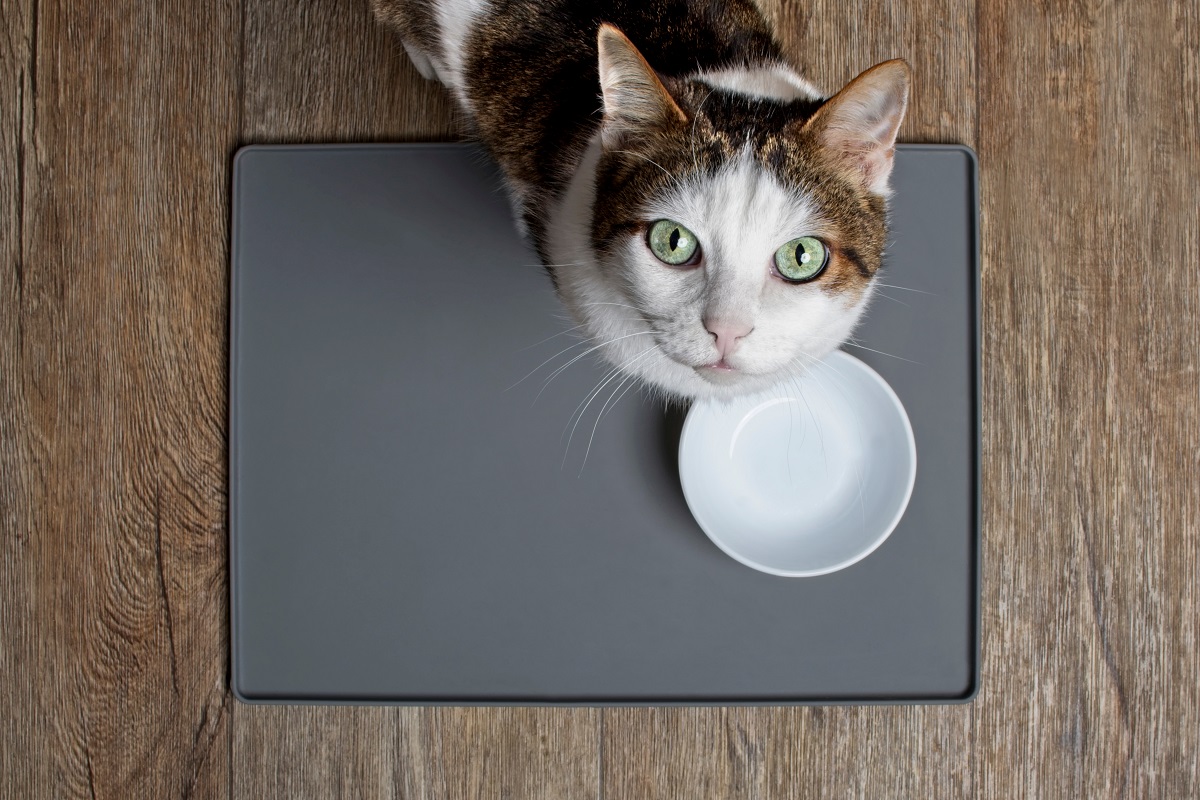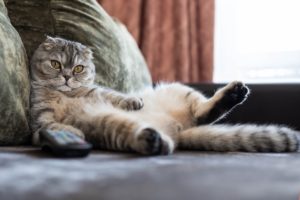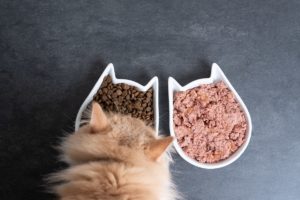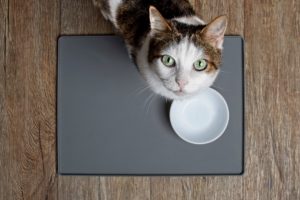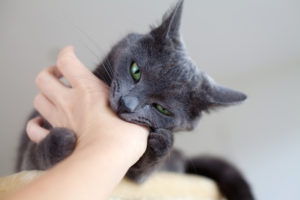If you’re like most cat owners, you either fill your cat’s bowl when it’s empty and let your kitty munch all day, or fill it up twice a day. Easy, right? What could be so hard about feeding a cat?!
Although some cats do fine and maintain their health pretty well with these feeding practices, as veterinarians we know that there is a better way to feed your cat! Based on your cat’s natural instincts and their biology, feeding small amounts throughout the day (and even nighttime) can help your cat be happier and healthier in mind and body. In fact, with some common kitty health problems, all we need to do is change how you feed your cat and your feeding frequency.
Natural Kitty Hunting Instincts
First, let’s talk about your cat’s natural instincts in this feeding guide—specifically, their drive to hunt, catch, kill and eat their prey. It’s sometimes hard to see our fluffy, cute, head-butting house cats as the hunters they are. However, cats evolved to be highly efficient predators —just like their “big cat” relatives. You can see these instincts in your beloved kitty every time you play with them and watch them stalk, pounce, roll, kick, and bite their favorite toys.
If your cat didn’t have you to provide them with their nutrition needs, they would consume a dozen (or more!) small pieces of prey per day. A cat’s stomach only holds a small amount of food at a time (roughly the size of a golf ball!), so their digestion is also designed to process small meals quite frequently.
As a cat owner, you can start to see how offering large amounts of food at 12-hour intervals is actually a highly unnatural feeding schedule for cats. Some cats will gorge themselves on food, and then vomit immediately afterward—the dreaded “scarf and barf” that comes from their stomach feeling way too full, way too fast.
When the food bowl is full all day and kitties are allowed to browse at their leisure, some cats will eat way more calories than they are burning—after all, they aren’t expending energy hunting for their food—and become an overweight cat.
Still, other cats will experience boredom and stress from not having their sharp minds stimulated by frequent hunts throughout the day. Yes, it is true: not being as active as nature intended causes a kitty stress! Stress can contribute to many health problems in cats, from urinating outside of the litterbox, to destructive behaviors around the home.
Feeding At Home As Nature Intended
How, then, should we feed our cats? By mimicking their natural way of eating as closely as possible! Since cats play with their prey before making it a meal, make sure to incorporate lots of play into your cat’s schedule around feeding times. This could mean scheduling multiple play sessions throughout the day for your cat, and then feeding a pre-measured small amount of food.
Not many pet owners have time to schedule a dozen play sessions a day with their cat (although we all wish we could!). Fortunately, there are now many varieties of food-dispensing toys on the market for your kitten, adult cat, or older cat.
Some of these food puzzles require your cat to solve a problem—like pulling out pieces of kibble one at a time from a skinny plastic tube, or nibbling pieces of kibble or smeared canned food from a mat with little dividers built-in. Many others try to simulate a hunt as closely as possible, and these are called “feline foraging” toys—the cat has to play with the toy in order to dispense small amounts of food at a time. Some toys are even shaped like small mice and your kitty has to “hunt” for their meal around the house! Take a look online for the many options available, and read reviews posted by fellow kitty lovers to decide which choices might align best with your cat’s favorite playstyle!
No matter what feeding routine you choose, make sure to always take into account your cat’s daily calorie needs. If you’re not sure how to get a cat to lose weight, your first focus should be to measure their portions to control their cat food intake. Measure the total amount of food you are feeding daily, and divide their calories into multiple small meals throughout the day to keep your cat’s diet healthy and promote a healthy weight.
Feeding for a Healthy and Happy Future
So, how often do you feed your cat, and should you make a change in their diet? By using your cat’s primal instincts, you can provide high-quality nutrition in a way that prevents many health problems—and make all of your cat’s nine lives as fulfilling as possible! If you’re looking for more information on topics like toxic food for cats, wet vs. dry cat food or want to learn more on how to support your pet’s nutrition, our vets are here to help.
Our AskVet Veterinarians are available to discuss all of your pet’s needs 24 hours a day, 7 days a week. Whether you have an immediate need or are looking to improve your pet’s overall wellbeing, just sign into your account and one of our friendly and knowledgeable veterinary experts will attend to your needs, no appointment required!
Written by:
Allison Ward, DVM
Dr. Allison Ward grew up in the suburbs of Washington, D.C. and started working in veterinary hospitals when she was 14 years old. After graduating from veterinary school in 2011, she completed a small animal rotating internship in New Jersey, followed by a neurology/neurosurgery internship in Miami. After completing this advanced training, Dr. Ward then moved on to general small animal practice. Dr. Ward’s professional interests include feline medicine, neurology, and pain management. Her passion for educating pet owners carries over into her work with AskVet, and she loves being able to help pets and their parents at all times of the day (and night!). She currently resides in sunny south Florida with her two cats, Larry and George.

